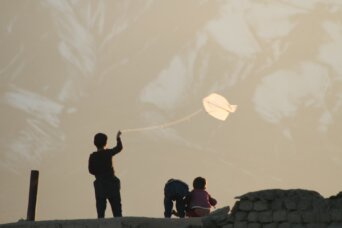- About
- Topics
- Picks
- Audio
- Story
- In-Depth
- Opinion
- News
- Donate
- Signup for our newsletterOur Editors' Best Picks.Send
Read, Debate: Engage.
| topic: | Humanitarian Aid |
|---|---|
| located: | Afghanistan |
| editor: | Shadi Khan Saif |
The present and future of millions of common people in Afghanistan are hanging by a thin thread of humanitarian aid as they find themselves caught between a hardline Taliban regime and a US-led isolation by the outer world. The entire country is literally on the lifeline of humanitarian assistance that is gradually fading.
The UN has warned that it will have to reduce the number of Afghans it is helping - from 38 percent to 8 percent by June because of a lack of funds. This means nearly all Afghans will go hungry as some 20,000 people are in a state of famine, and half of the population needs urgent help. Why?
Mainly because of the misplaced geo-strategic priorities of the US and the regional powers and the Taliban's stubbornness with regards to women’s rights, inclusivity in the government and respect for accountability to the nation.
Yes, there are other factors behind the sad state of affairs, such as climate change leading to drought and floods, the longstanding issues with the aid-dependent economy and so on, but the level of helplessness brought upon the people of Afghanistan since the fall of the West-backed government and the haphazard exit of the US and Allies is simply horrendous.
On top of that, the freezing of Afghanistan's state assets by the US as a pressure tool and leverage for political maneuvering is only hurting the millions of common people, particularly the poor and marginalised since the Taliban hardly care about providing services to the nation.
Instead, they are using it to their advantage to shift all the blame on the US and Allies for not releasing Afghanistan's state reserves. Ultimately, no country in the world seems ready to recognise the Taliban government, which means the population remains stateless.
Take a look at this: at least $3.8 billion (86 percent) of the $4.4 billion needed for humanitarian assistance this year remains unfunded in Afghanistan. At the same time, acute vulnerabilities continue to be compounded by spring risks, crippling economic decline and ruptures in basic services just as a new wave of terrorist attacks surge in various corners of the war-ravaged country.
How long can this stay like this? Donor fatigue is impending, and has already begun. The aid needs to be properly managed and eventually replaced with a sustainable economy.
As per the UN, in a context of increasing humanitarian needs and a simultaneous rise in operational complexities, the humanitarian community’s ability to continue to stay and deliver life-saving assistance will be contingent on flexible funds, enabling financial systems and assurances of aid worker-safety and a principled humanitarian response.
This all amounts to keeping Afghanistan hanging by a thin thread of aid while its own state reserves remain frozen and the country is kept totally isolated and abandoned by the world, locked under Taliban rule.
Photo by Farid Ershad

